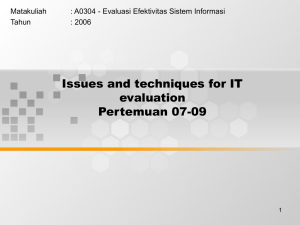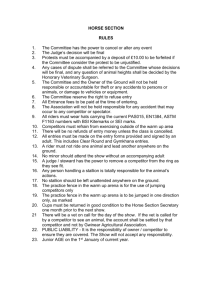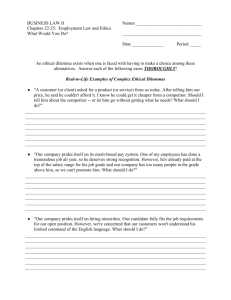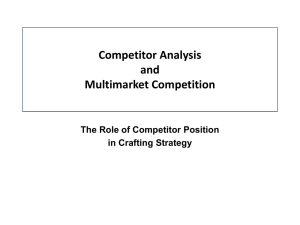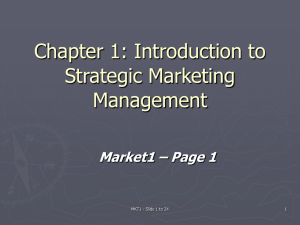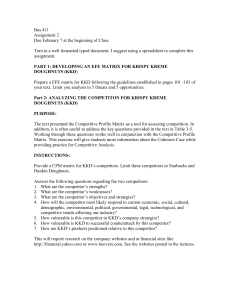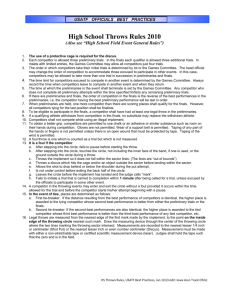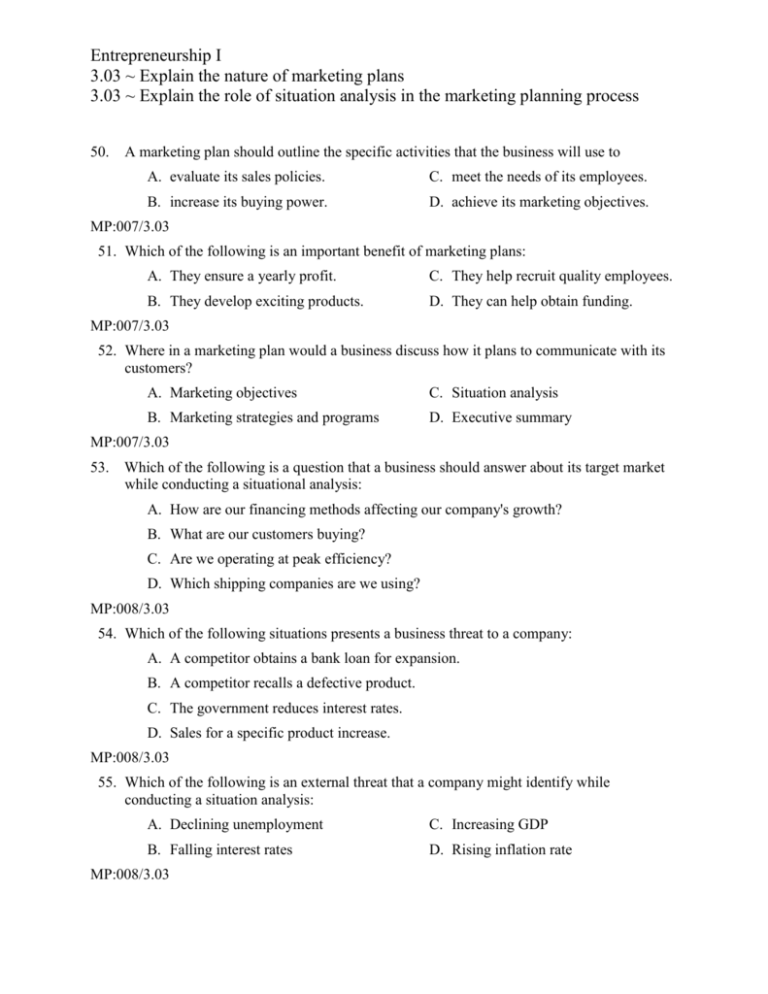
Entrepreneurship I
3.03 ~ Explain the nature of marketing plans
3.03 ~ Explain the role of situation analysis in the marketing planning process
50.
A marketing plan should outline the specific activities that the business will use to
A. evaluate its sales policies.
C. meet the needs of its employees.
B. increase its buying power.
D. achieve its marketing objectives.
MP:007/3.03
51. Which of the following is an important benefit of marketing plans:
A. They ensure a yearly profit.
C. They help recruit quality employees.
B. They develop exciting products.
D. They can help obtain funding.
MP:007/3.03
52. Where in a marketing plan would a business discuss how it plans to communicate with its
customers?
A. Marketing objectives
C. Situation analysis
B. Marketing strategies and programs
D. Executive summary
MP:007/3.03
53.
Which of the following is a question that a business should answer about its target market
while conducting a situational analysis:
A. How are our financing methods affecting our company's growth?
B. What are our customers buying?
C. Are we operating at peak efficiency?
D. Which shipping companies are we using?
MP:008/3.03
54. Which of the following situations presents a business threat to a company:
A. A competitor obtains a bank loan for expansion.
B. A competitor recalls a defective product.
C. The government reduces interest rates.
D. Sales for a specific product increase.
MP:008/3.03
55. Which of the following is an external threat that a company might identify while
conducting a situation analysis:
A. Declining unemployment
C. Increasing GDP
B. Falling interest rates
D. Rising inflation rate
MP:008/3.03
Entrepreneurship I
3.03 ~ Explain the nature of marketing plans
3.03 ~ Explain the role of situation analysis in the marketing planning process
KEY
50.D
Achieve its marketing objectives. A marketing plan is a written set of procedures or strategies for
attracting a target market to the business. It outlines all of the activities that the business plans to
use to achieve its marketing objectives. The marketing plan does not outline specific activities that
the business will use to increase its buying power, meet the needs of its employees, or evaluate its
sales policies.
SOURCE: MP:007/3.03
SOURCE: Perreault, W.D., Cannon, J.P., & McCarthy, E.J. (2008). Basic marketing: A marketing
strategy planning approach (16th ed.) [pp. 41-42]. Boston: McGraw-Hill/Irwin.
51. D
They can help obtain funding. An important benefit of marketing plans is that they can help the
marketing team obtain needed funding, either from the company budget or from outside investors.
Marketing plans outline important marketing information and strategies; they do not develop
products or recruit employees. While they contribute to a firm's success, marketing plans do not
necessarily ensure a yearly profit.
SOURCE: MP:007/3.03
SOURCE: MP LAP 1—A Winning Plan (Nature of Marketing Plans)
52. B
Marketing strategies and programs. The marketing strategies and programs section of the marketing
plan covers product, price, place (distribution), and promotion—the four P's of marketing. This
section of the plan would cover a business's plans for communicating with its customers. The
marketing objectives section of the plan lists the business's goals. The situation analysis is a
determination of the business's current marketing situation. The executive summary is an
introduction to the marketing plan.
SOURCE: MP:007/3.03
SOURCE: MP LAP 1—A Winning Plan (Nature of Marketing Plans)
53. B
What are our customers buying? A situation analysis is a determination of a business's current
situation and the direction in which the business is headed. A situation analysis evaluates many
internal and external factors. The business's customers (target market) are an external factor the
business considers when conducting a situation analysis. The business needs to know which
products the customers are buying so it can determine if it needs to make product line changes,
delete items, add items, etc. Answering questions about financing, efficiency, and shipping
companies do not help the business obtain information about its target market.
SOURCE: MP:008/3.03
SOURCE: Etzel, M.J., Walker, B.J., & Stanton, W.J. (2007). Marketing (14th ed.) [p. 632].
Boston: McGraw-Hill/Irwin.
Entrepreneurship I
3.03 ~ Explain the nature of marketing plans
3.03 ~ Explain the role of situation analysis in the marketing planning process
54. A
A competitor obtains a bank loan for expansion. A situation analysis is a determination of a
company's business situation and the direction in which the company is headed. By examining the
current internal and external factors that are affecting the company, it can act on opportunities, as
well as take steps to improve its situation when it detects certain threats and weaknesses. If a
competitor obtains a bank loan to expand, it means the competitor's business is growing—it could
be achieving more sales, which means there is potential for the competitor to take market share
from the company. When a competitor must recall a defective product, the company might benefit
because recalls can cost a lot of money, jeopardizing the competitor's situation. The company might
benefit from its competitor's recall because consumers might buy replacement items from the
company. Reduced interest rates could present an opportunity for the business because it can obtain
a loan for expansion and pay less interest. There is not enough information to determine if the
situation discussing the sales increase relates to the company or to its competitors.
SOURCE: MP:008/3.03
SOURCE: Longenecker, J.G., Moore, C.W., & Petty, J.W. (2003). Small business management:
An entrepreneurial emphasis (12th ed.) [pp. 42-43]. Cincinnati: Thomson/SouthWestern.
55. D
Rising inflation rate. A situation analysis is a determination of a company's current business
situation and the direction in which the company is headed. When a company conducts a situation
analysis, it evaluates many internal and external factors. Some external factors that a company
evaluates are the economic indicators that affect the overall health of the economy, such as the
interest rates, the unemployment rate, and the inflation rate. Inflation is the rapid rise in prices.
Rising inflation is a threat to a company because customers have less money to spend on the
company's products, which can negatively impact its sales. In addition, the company may also need
to spend more money for raw materials, which can lower the company's profitability. When interest
rates fall, customers are more likely to use credit or obtain loans to purchase goods and services,
which may benefit the company. Likewise, an increase in GDP and a decline in unemployment
indicate a strong economy in which customers are spending their money, which may positively
impact on the company's sales.
SOURCE: MP:008/3.03
SOURCE: Soloman, M.R., Marshall, G.W., & Stuart, E.W. (2008). Marketing: Real people, real
choices (5th ed.) [pp. 43-44]. Upper Saddle River, NJ: Pearson Prentice Hall.

